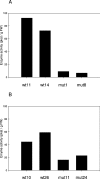UDP-glucose dehydrogenases of maize: a role in cell wall pentose biosynthesis
- PMID: 15969652
- PMCID: PMC1276940
- DOI: 10.1042/BJ20050800
UDP-glucose dehydrogenases of maize: a role in cell wall pentose biosynthesis
Abstract
UDPGDH (UDP-D-glucose dehydrogenase) oxidizes UDP-Glc (UDP-D-glucose) to UDP-GlcA (UDP-D-glucuronate), the precursor of UDP-D-xylose and UDP-L-arabinose, major cell wall polysaccharide precursors. Maize (Zea mays L.) has at least two putative UDPGDH genes (A and B), according to sequence similarity to a soya bean UDPGDH gene. The predicted maize amino acid sequences have 95% similarity to that of soya bean. Maize mutants with a Mu-element insertion in UDPGDH-A or UDPGDH-B were isolated (udpgdh-A1 and udpgdh-B1 respectively) and studied for changes in wall polysaccharide biosynthesis. The udpgdh-A1 and udpgdh-B1 homozygotes showed no visible phenotype but exhibited 90 and 60-70% less UDPGDH activity respectively than wild-types in a radiochemical assay with 30 microM UDP-glucose. Ethanol dehydrogenase (ADH) activity varied independently of UDPGDH activity, supporting the hypothesis that ADH and UDPGDH activities are due to different enzymes in maize. When extracts from wild-types and udpgdh-A1 homozygotes were assayed with increasing concentrations of UDP-Glc, at least two isoforms of UDPGDH were detected, having K(m) values of approx. 380 and 950 microM for UDP-Glc. Leaf and stem non-cellulosic polysaccharides had lower Ara/Gal and Xyl/Gal ratios in udpgdh-A1 homozygotes than in wild-types, whereas udpgdh-B1 homozygotes exhibited more variability among individual plants, suggesting that UDPGDH-A activity has a more important role than UDPGDH-B in UDP-GlcA synthesis. The fact that mutation of a UDPGDH gene interferes with polysaccharide synthesis suggests a greater importance for the sugar nucleotide oxidation pathway than for the myo-inositol pathway in UDP-GlcA biosynthesis during post-germinative growth of maize.
Figures







Similar articles
-
Novel characteristics of UDP-glucose dehydrogenase activities in maize: non-involvement of alcohol dehydrogenases in cell wall polysaccharide biosynthesis.Planta. 2006 Mar;223(4):858-70. doi: 10.1007/s00425-005-0207-7. Epub 2006 Feb 2. Planta. 2006. PMID: 16453102
-
Overexpression of UDP-glucose dehydrogenase in Escherichia coli results in decreased biosynthesis of K5 polysaccharide.Biochem J. 2003 Sep 15;374(Pt 3):767-72. doi: 10.1042/BJ20030365. Biochem J. 2003. PMID: 12775214 Free PMC article.
-
Molecular cloning and characterization of the human and mouse UDP-glucose dehydrogenase genes.J Biol Chem. 1998 Sep 25;273(39):25117-24. doi: 10.1074/jbc.273.39.25117. J Biol Chem. 1998. PMID: 9737970
-
Molecular genetics of nucleotide sugar interconversion pathways in plants.Plant Mol Biol. 2001 Sep;47(1-2):95-113. Plant Mol Biol. 2001. PMID: 11554483 Review.
-
Integration of Sugar Metabolism and Proteoglycan Synthesis by UDP-glucose Dehydrogenase.J Histochem Cytochem. 2021 Jan;69(1):13-23. doi: 10.1369/0022155420947500. Epub 2020 Aug 4. J Histochem Cytochem. 2021. PMID: 32749901 Free PMC article. Review.
Cited by
-
Genome-wide association mapping of seed oligosaccharides in chickpea.Front Plant Sci. 2022 Oct 24;13:1024543. doi: 10.3389/fpls.2022.1024543. eCollection 2022. Front Plant Sci. 2022. PMID: 36352859 Free PMC article.
-
Parallel proteomic and phosphoproteomic analyses of successive stages of maize leaf development.Plant Cell. 2013 Aug;25(8):2798-812. doi: 10.1105/tpc.113.112227. Epub 2013 Aug 9. Plant Cell. 2013. PMID: 23933881 Free PMC article.
-
Characterization of a cinnamoyl-CoA reductase 1 (CCR1) mutant in maize: effects on lignification, fibre development, and global gene expression.J Exp Bot. 2011 Jul;62(11):3837-48. doi: 10.1093/jxb/err077. Epub 2011 Apr 14. J Exp Bot. 2011. PMID: 21493812 Free PMC article.
-
Novel characteristics of UDP-glucose dehydrogenase activities in maize: non-involvement of alcohol dehydrogenases in cell wall polysaccharide biosynthesis.Planta. 2006 Mar;223(4):858-70. doi: 10.1007/s00425-005-0207-7. Epub 2006 Feb 2. Planta. 2006. PMID: 16453102
-
UDP-sugar pyrophosphorylase is essential for pollen development in Arabidopsis.Planta. 2006 Aug;224(3):520-32. doi: 10.1007/s00425-006-0240-1. Epub 2006 Mar 24. Planta. 2006. PMID: 16557401
References
-
- Feingold D. S., Avigad G. Sugar nucleotide transformations in plants. In: Preiss J., editor. The Biochemistry of Plants, A Comprehensive Treatise, vol. 3. New York: Academic Press; 1980. pp. 101–170.
-
- Mohnen D. Biosynthesis of pectins. In: Seymor G. B., Knox J. P., editors. Pectins and their Manipulation. Oxford, U.K.: Blackwell Publishing/CRC Press; 2002. pp. 52–98.
-
- Seifert G. J. Nucleotide sugar interconversions and cell wall biosynthesis: how to bring the inside to the outside. Curr. Opin. Plant Biol. 2004;7:277–284. - PubMed
-
- Carpita N. C. Structure and biogenesis of the cell walls of grasses. Annu. Rev. Plant Physiol. Plant Mol. Biol. 1996;47:445–476. - PubMed
-
- Loewus F., Chen M. S., Loewus M. W. The myo-inositol oxidation pathway to cell wall polysaccharides. In: Loewus F., editor. Biogenesis of Plant Cell Wall Polysaccharides. New York: Academic Press; 1973. pp. 1–27.
Publication types
MeSH terms
Substances
LinkOut - more resources
Full Text Sources
Other Literature Sources
Research Materials

